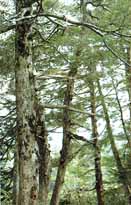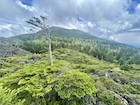Conservation Status

Tsuga diversifolia
(Maxim.) Mast. (1881)
Common names
Northern Japanese hemlock; コメツガ KOME-TSUGA [Japanese].
Taxonomic notes
Synonymy: see POWO for the 5 synonyms, none in common use. Molecular evidence places Tsuga diversifolia sister to T. ulleungensis in a clade sister to all of the other Asian hemlock species (Feng et al. 2021), but its morphology is very close to T. sieboldii, and it was placed sister to T. sieboldii in some of the earlier molecular analyses (Holman et al. 2017).
Description
Evergreen trees to 25 m tall and 60 cm dbh, with a straight or curved trunk that often forks above half of height. Bark on trunk scaly, furrowed, dark brown-grey. Crown of mature trees broad, domed, dense, more open in old trees. Twigs first orange-brown, short-pubescent; later dull brown, glabrous, ridged and grooved between appressed, decurrent pulvini. Foliar buds obovoid 2-3 × 2-2.5 mm, not or slightly resinous, dark brown. Leaves dark lustrous green, pectinate, but shorter leaves above shoot assurgent, (5-)8-15(-18) × 2 mm, ligulate-linear, slightly wider near truncate or emarginate apex, slightly curved or straight, flattened, grooved above; stomata in two broad, white bands separated by a midrib on the abaxial (under) side. Pollen cones 3-5 mm long, yellow when shedding pollen. Seed cones numerous on outer branches of the crown, on 3-4 mm long pubescent peduncles, ovoid when closed, subglobose when opened, (1.5-)2-2.5 cm long, 1.5-2 cm wide, green or purplish green, ripening to shiny, reddish or dark brown. Seed scales nearly circular to obovate, flat or slightly convex, spreading at ca. 90° from rachis, 8-12 × 7-10 mm; abaxial surface smooth or finely wrinkled, with imprints of two overlapping scales; base broad-cuneate, sometimes short-pedicellate. Bracts broad, truncate, with two small apical teeth, 2-3 mm long. Seeds ovoid, ca. 3 × 2 mm, (dark) brown; seed wings obliquely ovate, 6-8 × 3-4 mm, yellowish or orange-brown, transparent (Farjon 2010). See García Esteban et al. (2004) for a detailed characterization of the wood anatomy.
Distribution and Ecology
Japan: Honshu and Kyushu, at 700-2000 m elevation (Farjon 1990). Typically found on podzolic soils derived from igneous rocks; climate cool temperate maritime, with snowy winters and rainy summers; annual precipitation 1000-2500 mm. Very shade tolerant, and often the most dominant species in mixed conifer forest. Common associates include Picea jezoensis, Abies homolepis, A. veitchii, A. mariesii at high elevations, Larix kaempferi, Pinus parviflora, Thuja standishii, and Thujopsis dolabrata var. hondae. Hardwood associates include species of Alnus, Betula, Quercus, and Sorbus (Farjon 2010). Hardy to Zone 5 (cold hardiness limit between -28.8°C and -23.3°C) (Bannister and Neuner 2001).
Remarkable Specimens
The oldest known living specimen, 462 years, was documented in a tree-ring chronology covering the period 1540-2001 (crossdated after 1543), collected in south-central Honshu by K. Yasue (doi.org/10.25921/1q8e-5b57). Only one chronology has been collected for this species, so it is reasonable to suppose that older trees could be found.
Ethnobotany
There is a long and continuing history of exploitation for timber. The wood is relatively dense and hard with sometimes an attractive figure, used for finish carpentry and furniture. It is also a common ornamental, popular in bonsai culture, though still not often seen in Europe or North America (Farjon 2010). Like Tsuga mertensiana it grows slowly, usually a desirable feature in an ornamental.
It has been used in a variety of dendroclimatic studies in northern Japan, as well as in ecological studies (Sawada and Kaji 1992, Fujiwara and Ohta 1994); the old tree name above was used in a dendroclimatic temperature reconstruction (PAGES 2k Consortium 2013).
Observations
I don't know of any especially good places to see T. diversifolia, but the observations listed on iNaturalist (accessed 2021.12.18) provide a good selection of places where people have seen it recently.
Remarks
The epithet refers to the varying lengths of needles that can be found on a shoot.
Citations
Farjon, Aljos. 1990. Pinaceae: drawings and descriptions of the genera Abies, Cedrus, Pseudolarix, Keteleeria, Nothotsuga, Tsuga, Cathaya, Pseudotsuga, Larix and Picea. Königstein: Koeltz Scientific Books.
Feng, Yuan-Yuan, Ting-Ting Shen, Cheng-Cheng Shao, Hong Du, Jin-Hua Ran, and Xiao-Quan Wang. 2021. Phylotranscriptomics reveals the complex evolutionary and biogeographic history of the genus Tsuga with an east Asian-North American disjunct distribution. Molecular Phylogenetics and Evolution 157:107066. https://doi.org/10.1016/j.ympev.2020.107066.
FFPRI = Forestry and Forest Products Research Institute. Apr-1996. Introduction to Forestry And Forest Products Research Institute. http://ss.ffpri.affrc.go.jp/outline.html, accessed 1998.10.12, now defunct.
Fujiwara T. and Ohta S. 1994. Tree ring networks for climate changes, forest decline and wood quality in Japan. In Park Won-Kyu, Frank W. Telewski and Kim J.-S., eds., Proceedings of the International Symposium on Global Change and Forests. Journal of Korea Forestry Energy 14(1): 72-79.
Holman, G., P. Del Tredici, N. Havill, N. S. Lee, R. Cronn, K. Cushman, S. Mathews, L. Raubeson, and C. S. Campbell. 2017. A new species and introgression in eastern Asian hemlocks (Pinaceae: Tsuga). Systematic Botany. 42(4):733–746.
Masters, M. T. 1881. On the conifers of Japan. Journal of the Linnaean Society, Botany 18:473-524 (p. 514). Available: Biodiversity Heritage Library, accessed 2021.12.18.
PAGES 2k Consortium. 2013. Continental-scale temperature variability during the past two millennia. Nature Geoscience 6:339-346. doi: 10.1038/NGEO1797
Sawada H. and Kaji M. 1992. Studies on the regeneration dynamics of the natural forests in the Chichibu Mountains, central Japan II: Processes of the regeneration caused by wind damage in a subalpine coniferous forest ca. 110 and 150 years ago. Bulletin of the Tokyo University Forests 87: 175-193 [in Japanese with English summary].
See also
Elwes and Henry 1906-1913 at the Biodiversity Heritage Library. This series of volumes, privately printed, provides some of the most engaging descriptions of conifers ever published. Although they only treat species cultivated in the U.K. and Ireland, and the taxonomy is a bit dated, still these accounts are thorough, treating such topics as species description, range, varieties, exceptionally old or tall specimens, remarkable trees, and cultivation. Despite being over a century old, they are generally accurate, and are illustrated with some remarkable photographs and lithographs.



